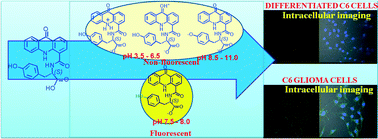Stitching of tyrosine and 10H-acridin-9-one: turn-ON fluorescence in the narrow pH range 7.4–8.5 and intracellular labelling of cancer cells†‡
Abstract
We tailored 10H-acridin-9-one and (S)-tyrosine into 3-(4-hydroxyphenyl)-2-[(9-oxo-9,10-dihydroacridine-4-carbonyl) amino]propionic acid (2). 2 underwent pH dependent protonation/deprotonation and the effect was harnessed in terms of change in the fluorescence. The characteristic fluorescence change in the molecule in the pH 7.5 ± 1 range and its cell permeability allowed us to label cancer cells.


 Please wait while we load your content...
Please wait while we load your content...